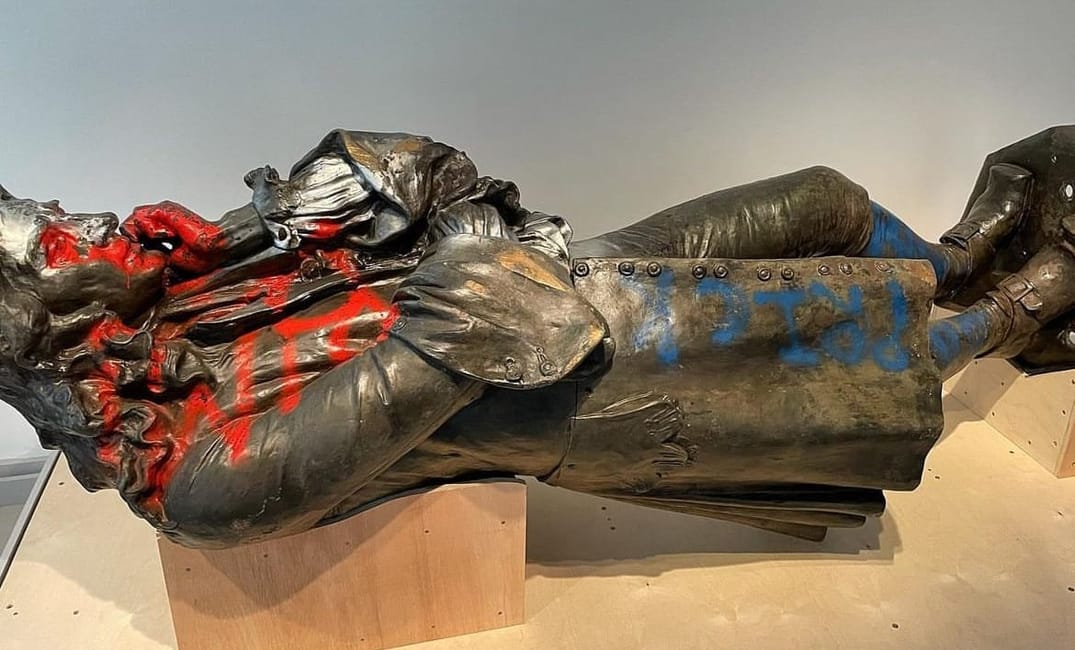✏️ Milou Klein
It started with the statue of Edward Colston in Bristol a few weeks ago. Like dominos, one by one, statues around the world are being toppled and torn down whilst packs of protesters and bystanders cheer and clap. However, there are people who still oppose the removal of the statues, in an effort to continue benefiting from the system of oppression it represents.
Many politicians have spoken out against the removal of the statue of Edward Colston in Bristol. Nigel Farage, ever so sensible and rational, tweeted that “a new form of the Taliban was born in the UK today”. Keir Starmer, leader of the Labour Party, said while appearing on LBC that the means were “completely wrong” and the removal of the statue “shouldn’t be done that way.” He did, however, argue that the statue should have been taken down a long time ago. One cannot help but wonder why Starmer is only speaking about it now, then, if he agrees it should have been taken down ages ago.
A spokesperson for Downing Street has also commented, saying that the tearing down of the statue was a criminal act for which the people who were responsible should be held accountable. The common denominator between these three politicians? All powerful, privileged, white males. The similarity between them and the men being glorified through these statues can hardly go unnoticed.
Most strikingly, many of these criticisms seem to insinuate that people have simply woken up one day and decided the statues needed to be removed. In reality, many have been fighting for this for years, even before recent events.
In Bristol, a movement called Countering Colston has already been fighting for several years to “stop publicly celebrating him and to acknowledge and repair, as far as possible, the negative effects in the present day of historical slavery”. There are (or were until recently) schools, streets, venues, organisations, events and much more named after Colston because he donated exceptional amounts of money to the city, the university and many churches. However, one does not cancel out the other.
Colston was, first and foremost, a man who made his money by trading in people, an objectively despicable and heinous practice of which many still experience the negative consequences every day.
Countering Colston has, in many of their initiatives, been successful. However, there are still places named after Colston and he continues to be a presence in Bristol. Following ‘proper procedure’ then, it has taken them several years to get some of the names changed. After hundreds of years of oppression, do we really want to wait several more years, or even centuries, solely to follow ‘proper procedure’?
Another example of this is the Rhodes Must Fall movement. The first protest, in 2015, gained international attention, with dozens of protesters throwing shit at the statue of the white supremacist and British imperialist on the campus of the University of Cape Town. This eventually led to the removal of the statue.
Over five years later, the Oxford branch of this movement is still protesting to demand the removal of another statue of Cecil Rhodes at Oxford University. Protests are being held to demand that the statue, which students argue does not represent their values, be finally removed. Similar protests that have been taking place since 2015 have not yet ensured the removal of this statue.
Many academics, however, argue that the statue merely reflects history, and should not be removed. Universities in the UK, including Oxford, have long been criticised for being overwhelmingly white, in curriculum, student body and academic staff. Again, I argue, it is completely contradictory to argue that ‘proper procedure’ must be followed, when those who look over proper procedure benefit from the system of oppression and white supremacy.
This argument also seems to be made in Keir Starmer’s criticism, and that of those who agree with him, that “it should have been brought down properly with consent and put in a museum”. This ignorant argument enforces the idea that taking down a statue of a slave trader can only be taken down with the consent of a government, largely filled with people who still benefit from the historical events that Colston represents.
How can we be expected to follow ‘proper procedure’ when there so clearly still exists a sentiment of pride and nostalgia towards British imperialism?
For those arguing that to take down such statues constitutes erasing history, I argue it corrects it. What white people, including myself, need to realise, is that these statues represent a wrongful depiction of history and of current times. For years, we have blindly walked the streets of our cities, without noticing the glorification of historical figures that most certainly do not deserve this.
We are taught a historical narrative in which the white man is seen as a saviour, an entrepreneur, a philanthropist when, in reality, the complete history does not reflect this. To continue glorifying these figures through statues, charities and naming things after them, would be to continue misrepresenting history. The removal of these statues, on the other hand, is history in the making.
While some may not agree with the manner in which the statues are being taken down, I argue the most important thing is that they are being taken down, now and forever. The continued glorification and whitewashing of history we see everywhere ensures that anti-racist efforts will be less successful than they can and should be.
Whilst we are criticising the racist leaders of today, we must also look at the history of glorification of racists that brought us here. We need to have no place in society for a storyline of history that neglects Black history, while glorifying white racists.
Thanks for reading our article! We know young people’s opinions matter and really appreciate everyone who reads us.
Give us a follow on Instagram, Twitter and Facebook to stay up to date with what young people think.

